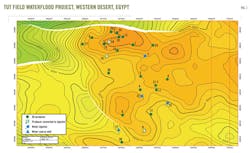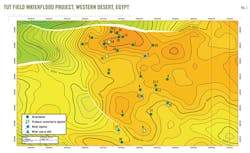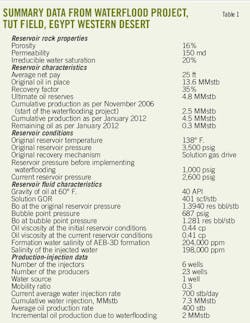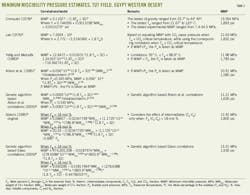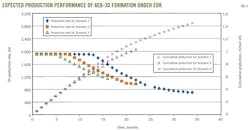Mahmoud Abu El Ela
Cairo University
Cairo
Tut field has proved to be feasible for the application of enhanced oil recovery technology.
The field is on the Khalda concession in the north part of Egypt's Western Desert and is under waterflood. Discovered in 1986, the field currently has 50 oil producing wells and 11 water injection wells.
A recent investigation on the applicability of using EOR method in Tut field was conducted. Preliminary screening was carried out to select the most suitable method for the Alam El Bueib-3D (AEB-3D) formation, one of the field's producing zones. The incremental production for potentially applicable EOR techniques to AEB-3D was quantified. The analysis of the screening results is based on successful EOR field application worldwide.
Results indicate CO2 miscible flooding to be the most appropriate and promising EOR method for the AEB-3D. The study also showed that CO2 can be an attractive injection fluid because of (1) the availability of CO2 and (2) miscibility could be achieved under current reservoir conditions.
Using a water alternating gas process with a WAG ratio of 0.5, incremental production of 1.44 million stock-tank bbl (stb) or a 10.8% recovery factor could be achieved.
The study's results encourage Khalda Petroleum Co. to investigate implementing CO2 injection in other formations and fields on KPC's concession. It is expected that application of such technology will yield incremental oil recovery of about 30 million stb assuming a 10% additional recovery factor.
Tut field EOR potential
Tut field produces oil from the Alam El Bueib, Kharita, and Bahariya formations.
The AEB-3D interval has two main sand bodies: upper and lower. The interval is perforated and produces in most of the wells. AEB-3D has 23 oil producing wells and six water injection wells, including three converted former oil producers (Fig. 1). The zone produced under depletion drive until November 2006, when water injection began.
Table 1 shows the fluid and rock properties of AEB-3D.1
Volumetric estimates indicated that the zone had 13.6 million stb of OOIP. Fig. 2 shows the production performance of AEB-3D. As of November 2006 and at the end of the primary recovery mechanism stage, the status was as follows:
1. Cumulative production from the zone was 2.5 million bbl, or 18% of the oil in place.
2. The estimated reservoir pressure of AEB-3D was 1,000 psig compared with 3,500 psig initially.
Since waterflooding started in that zone, an incremental 2 million bbl from existing wells has been produced (an incremental of 15% of OOIP), and the reservoir pressure increased to 2,600 psi from 1,000 psi. The zone is producing 400 b/d of oil from five wells as the field had several wells shut in due to normal depletion.
The operator expects waterflooding of the AEB-3D to increase the recovery factor to 35%, resulting in an ultimate recovery of 4.8 million bbl at the end of secondary recovery.
This waterflooding system is a closed system because one of the shut-in well was converted into a water source well from AEB-3E. This well supplies injection water for the AEB-3D injectors. A good practice is to use a closed system to reduce or eliminate water treatment.
Preliminary EOR screening
An investigation on the applicability of using EOR in Tut field sought to determine how much more oil could be recovered and what techniques could be applied at what cost.
Preliminary screening was initially carried out using specialized software (graphical user interface EORgui) to nominate the most suitable EOR technologies for the AEB-3D formation. Through the use of the EORgui software, the rock and fluid properties along with the production data and remaining reserves of AEB-3D were assessed against the EOR screening criteria.
Once all the necessary data of AEB-3D is input to the software, the relative criteria fit to the input data is calculated. Fig. 3 presents the summary of the screening results for the AEB-3D. The coloring scheme in Fig. 3 is based on the degree to which the criteria are met or not. A cell colored red indicates the criterion is not met, whereas light green cell shows the criterion is just met, and a dark green cell signifies the criterion is well met.
The results indicate that the appropriate EOR methods for the AEB-3D appear to be CO2 injection, immiscible gas injection, and combustion. Based on the history of successful EOR project results, the CO2 injection (miscible flooding) technology seems to be the most appropriate EOR methods for the AEB-3D.
Worth mentioning, immiscible displacements are less effective than miscible flooding; while, the combustion method requires more control, is suitable for heavy oil, and has limited successful field applications.
Chemical flooding is discouraged in the AEB-3D due to high salinity. Formation water salinity above 200,000 ppm causes problems in degradation, difficulty of designing stable surfactant/polymer systems; and-or consumption of the chemicals used in the process.2 3
Steam methods are not recommended in Tut field due to the AEB-3D oil's relatively low viscosity and excessive reservoir depth. The restriction of thermal processes to relatively deep reservoirs is because of potential heat losses through lengthy wellbores. Nitrogen and flue gas injection are not recommended, either, due to the oil viscosity.
Based on the screening analysis, it is found that CO2 injection has the most potential for future miscible flood project in the AEB-3D in Tut field.
CO2 availability
CO2 can be an attractive injection fluid because the following:
1. Availability of CO2 gas: Large quantities of CO2 are available as by products from the Khalda gas plants. The Salam and Tarek Khalda Western Desert gas plants are 5 km from Tut field and process gas condensate from Salam field, Qasr field, South Umbarka, and an oil plant's associated gas. Currently, the project produces about 500 MMscfd of gas and 40,000 stb/day of condensate.
The plants include a gas sweetening system (two-stage membrane packages) to separate CO2 from the treated gas. The by-product from the membrane systems is permeate gas (30 MMscfd) containing 70 mol % CO2. Transport of CO2 rich gas from the Tarek and Salam plants to Tut field is the key economic consideration.
2. As an environmental advantage, injection of CO2 is an economic way of reducing CO2 emissions. In addition, the CO2 by-product will be reused.
One of the critical issues in the application of the CO2 injection is the pressure requirements for the miscibility of the CO2. The minimum miscibility pressure (MMP) of the CO2 with the reservoir oil of the AEB-3D was estimated using several correlations as shown in Table 2.4-9 The study revealed that the miscibility of the CO2 could be achieved at an average pressure of 1,750 psi. Preferably, the injection pressure at the start of a CO2 flood should be at least 14 bar above the MMP to achieve miscibility of CO2 and reservoir oil.10 Higher pressure might be needed to render the gas miscible with oil because the available gas from the Salam or Tarek plant is CO2 rich gas that contains 70% CO2 and 30% hydrocarbons gases.11
The AEB-3D reservoir pressure has already been increased by injecting water. The current reservoir pressure of 2,600 psi is higher than the estimated MMP with a reasonable margin that will easily achieve the miscibility of the CO2 injection with the reservoir crude.
The correlations approach is useful for screening reservoirs for suitability for miscible processes, especially if there is sufficient margin in the operating pressure to allow for potential error in correlation estimates. However, the pressure required for dynamic miscibility with CO2 will be determined from displacement experiments.
Potential of the AEB-3D formation
Because of differences in density and viscosity between the injected fluid and the reservoir fluid(s), the miscible process might suffer from poor mobility.
Viscous fingering and gravity override might also occur. The WAG process is suggested in order to take advantage of the high microscopic displacement efficiency of the miscible process and the high macroscopic displacement efficiency of a waterflood.
A balance between amounts of injected water and CO2 gas must be achieved. Too much CO2 will lead to viscous fingering and gravity override of the gas, whereas too much water could lead to the trapping of reservoir oil by the water.
The CO2 miscible flooding predictive model of EORgui software was used to study the production performance of the AEB-3D under the WAG process. The reservoir and fluid data were used in the model for a 40-acre pilot pattern area.
Three scenarios were considered. The recovery factor and the production forecast for each scenario were estimated. The main parameter in the proposed scenarios is the value of the WAG ratio for CO2 injection: 0.5, 1.0, and 2.
Once the CO2 miscible flooding predictive model is used, the data are reimported back from the quick screening model into the application. Then, the model was used to predict the production performance and estimate the recovery factors of the AEB-3D.
A comparison between the production rate and cumulative oil produced of the three scenarios (full field scale) is presented in Fig. 4. It is noticed that Scenario 1 will yield an incremental cumulative production of about 1.44 million stb and an incremental recovery factor of 10.8% using a WAG ratio of 0.5, while an increase in WAG ratio will yield lower cumulative production and recovery in Scenarios 2 and 3. This is achieved with considering the economic limit of the water cut as 70%.
This result indicates that the ultimate recovery can being 35% of OOIP in primary and waterflood stages, plus 10.8% using WAG process, for a total of 45.8% of OOIP.
The predicted recovery factor in this study is consistent with available data from successful EOR projects elsewhere. Most of the results on the CO2 solvent flooding report that the ultimate recovery ranges between 5% and 10% of OOIP.
The model showed that the ratio of cumulative CO2 injection to cumulative incremental oil production, which is the cumulative utilization of the injected CO2, is about 2 Mscf/bbl. This value needs to be further studied and investigated in the laboratory because most of the reported results on the CO2 solvent flooding show that the utilization factors of solvent is 10 Mscf/bbl of incremental oil recovered.
The results of this study encourage investigating the possibility of using CO2 injection in other formations and fields of KPC's Western Desert concession. It is expected that application of such technology will yield incremental oil recovery of about 30 million stb assuming a 10% additional recovery factor. The following issues shall be assessed to finalize the feasibility of the project:
• Total volume of the required CO2.
• Design of the gas pipeline network from the CO2 source location into the injectors.
• The surface facilities requirements.
• Corrosion and handling of the produced CO2.
• Metallurgy of the new facilities.
Acknowledgments
The author thanks Khalda Petroleum Co. for permission to publish this article and Prof. Helmy Sayyouh and Ahmed Shehata for support during its preparation.
References
1. Abu El Ela, M., and Mahgoub, I., "Waterflood boosts oil production from field in Egypt," OGJ, Jan. 7, 2008, p. 43.
2. Taber, J.J., et al., "EOR screening criteria revisited—Part 1: Introduction to screening criteria and enhanced recovery field projects," Paper No. SPE 35385-PA, SPE Reservoir Engineering Journal, Vol. 12, No. 3, August 1997, p. 189.
3. Sayyouh, M.H., and Al-Blehed, M., "Screening criteria for enhanced recovery of Saudi crude oils," Energy Sources, Vol. 12, Issue 1, 1990, p. 71.
4. Cronquist, C., "Carbon dioxide dynamic displacement with light reservoir oils," presented at the 1978 US DOE Symposium, Tulsa, Aug. 28-30, 1978.
5. Lee, J.I., "Effectiveness of carbon dioxide displacement under miscible and immiscible conditions," Report RR-40, Petroleum Recovery Inst., Calgary, March 1979.
6. Yellig, W.F., and Metcalfe, R.S., "Determination and prediction of CO2 minimum miscibility pressures," JPT, January 1980, p. 160.
7. Alston, R.B., et al., "CO2 minimum miscibility pressure: a correlation for impure CO2 streams and live oil systems," SPEJ, April 1985, p. 268.
8. Emera, M.K., and Sarma, H.K., "Use of genetic algorithm to estimate CO2-oil minimum miscibility pressure—a key parameter in design of CO2 miscible flood," Journal of Petroleum Science and Engineering, Vol. 46, p. 37, 2005.
9. Glaso, O., "Generalized minimum miscibility pressure correlation," SPEJ, December 1985, p. 927.
10. Terry, R.E., "Enhanced oil recovery," in Encyclopedia of Physical Science and Technology, Third Edition, Vol. 18, Robert A. Meyers, ed., Academic Press, 2001, pp. 503-18.
11. Carcoana, A., "Applied enhanced oil recovery," Prentice-Hall Inc., 1992.
Bibliography
Abu El Ela, M., et al., "Thermal heavy-oil recovery projects succeeded in Egypt, Syria," OGJ, Dec. 22, 2008, Vol. 106, No. 48.
Sandrea, I., and Sandrea, R., "Global oil reserves—1: Recovery factors leave vast target for EOR technologies," OGJ, Nov. 5, 2007, Vol. 105, No. 41.
Moritis, G., "2006 Worldwide EOR Survey," OGJ, Apr. 17, 2006, Vol. 104, No. 15, p. 46.
Koottungal, L., "2012 Worldwide EOR Survey," OGJ, Apr. 2, 2012, Vol. 110, No. 4.
Alvarado, V., and Manrique, E., "Enhanced oil recovery: an update review," Energies, Aug. 27, 2010, Vol. 3, No. 9, p. 1,529.
Manrique, E.J., et al., "EOR field experiences in carbonate reservoirs in the US," Paper No. SPE 100063-PA, SPE Reservoir Evaluation & Engineering Journal, December 2007, Vol. 10, No. 6, p. 667.
Farouq Ali, S.A., et al., "Practical heavy oil recovery," draft volume, 1997.
BP Statistical Review of World Energy, June 2011.
The author
Mahmoud Abu El Ela ([email protected]) is an associate professor at the Petroleum Engineering Department, Cairo University, Egypt. He also works as a project manager at WorleyParsons Engineers Egypt Ltd. Previously, he was lead process engineer at WorleyParsons, an assistant professor at the Petroleum Engineering Department at Cairo University, petroleum process consulting engineer for Khalda Petroleum Co., and a research engineer at Woodside Research Foundation at Curtin University of Technology in Australia. Since 1997, he has been a technical consultant in petroleum engineering for national and international companies. He has a BSc and MSc in petroleum engineering from Cairo University and a PhD from Curtin University of Technology.
